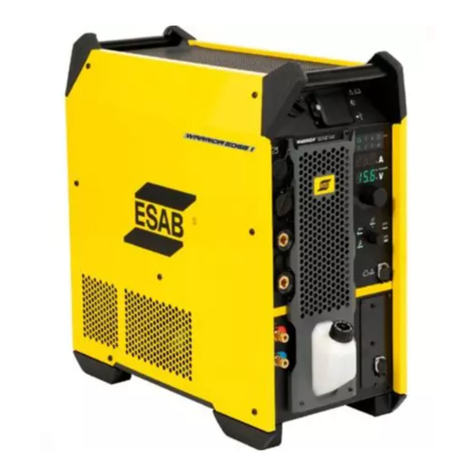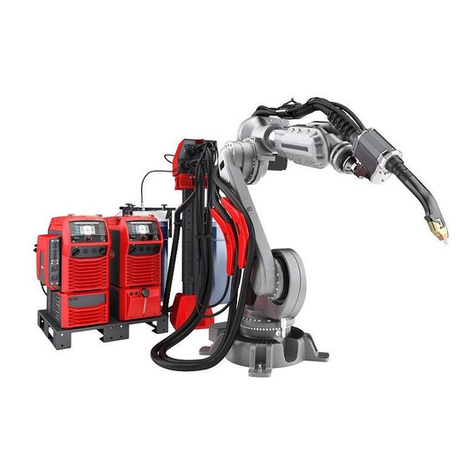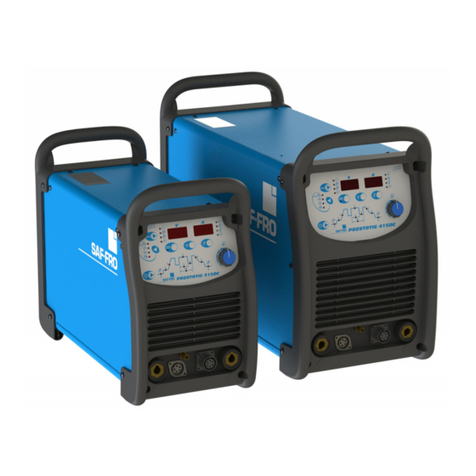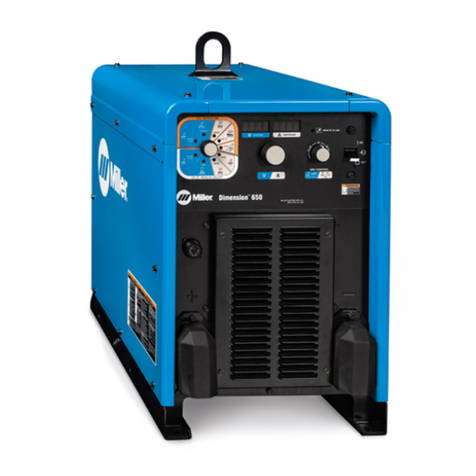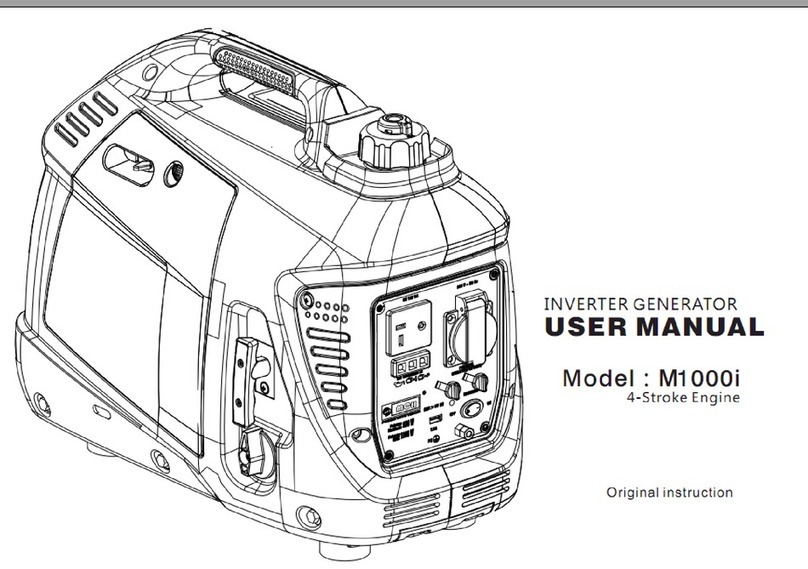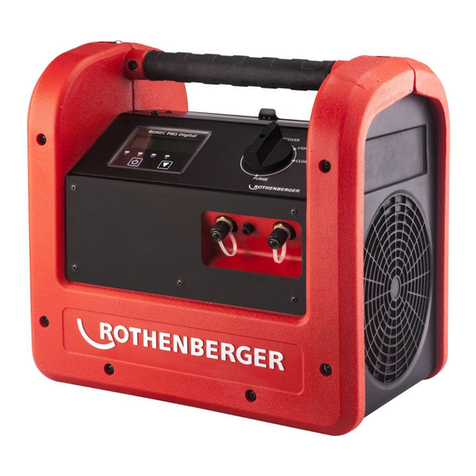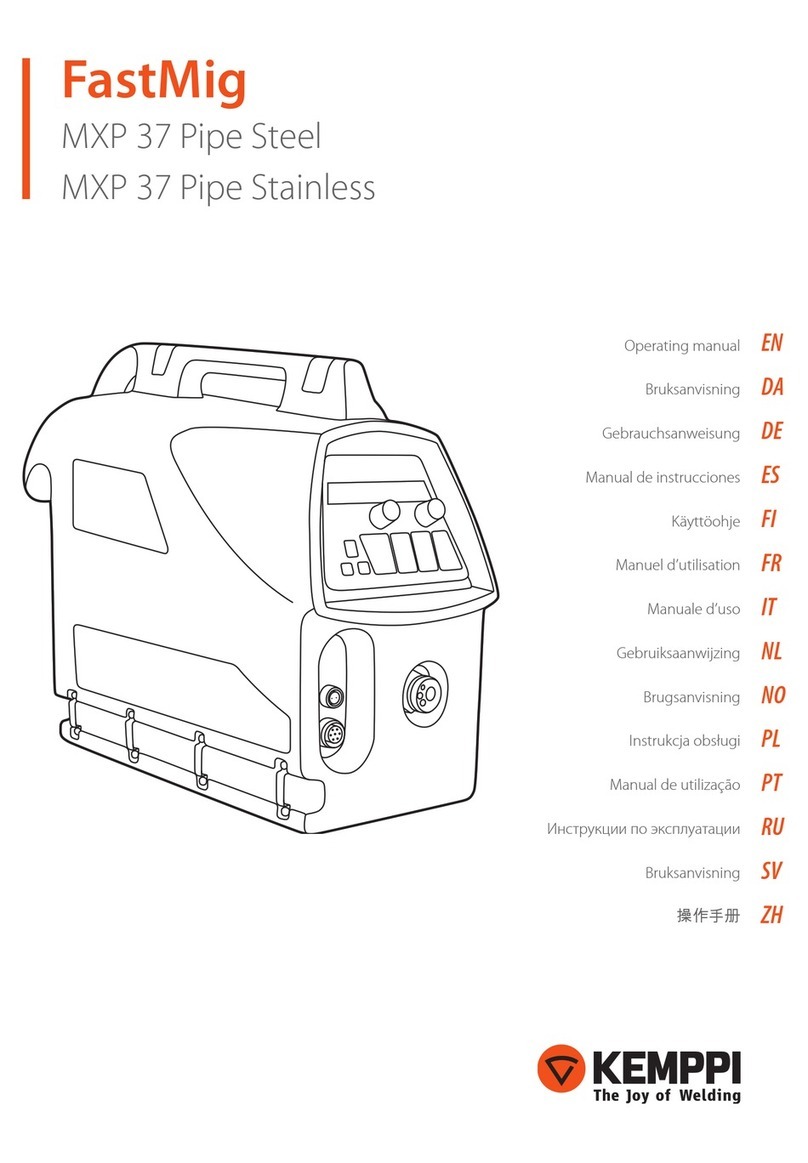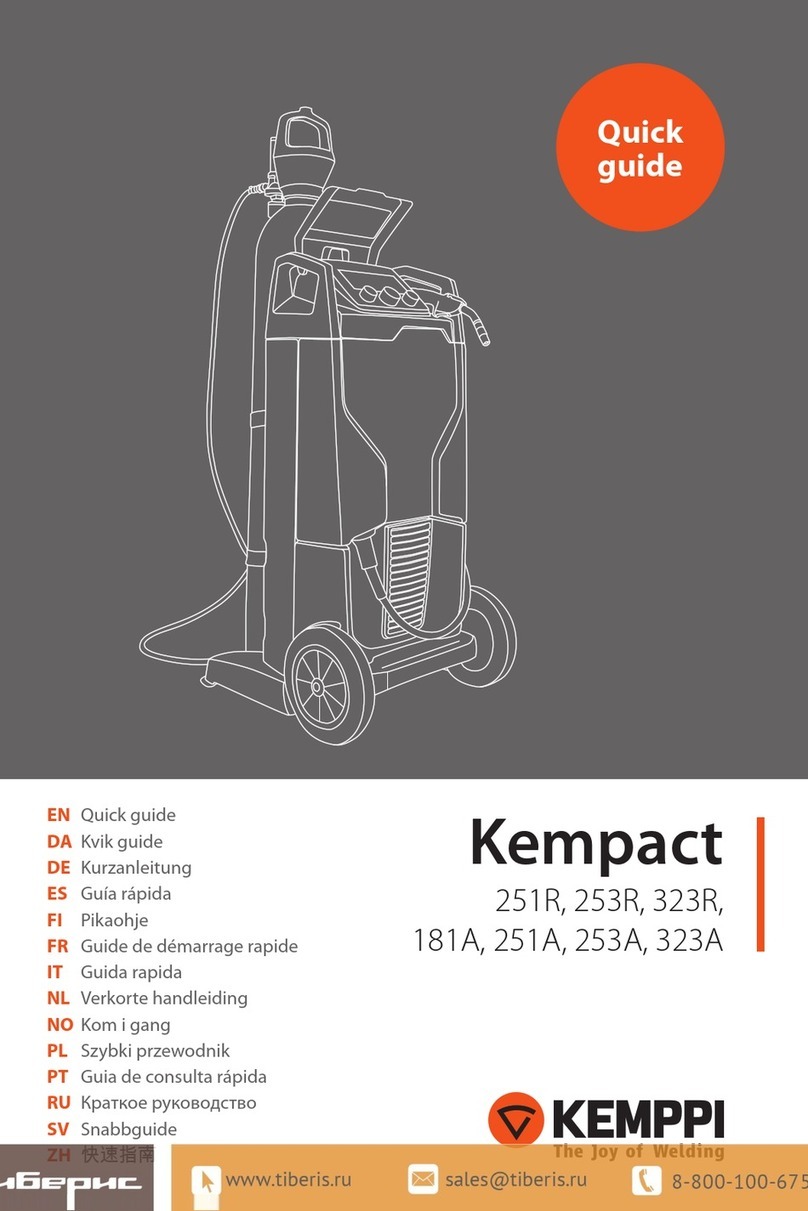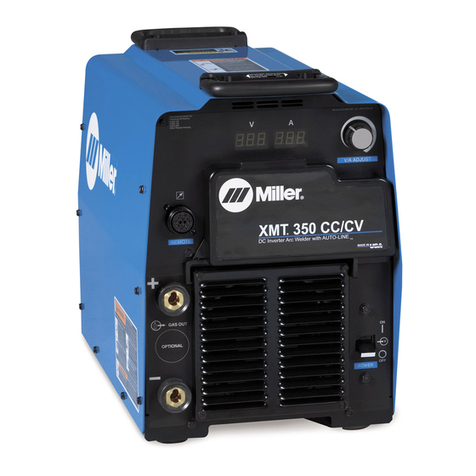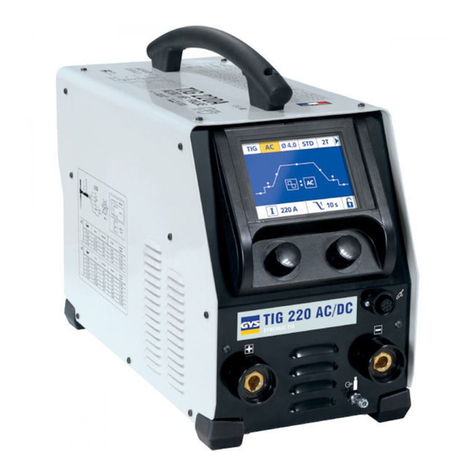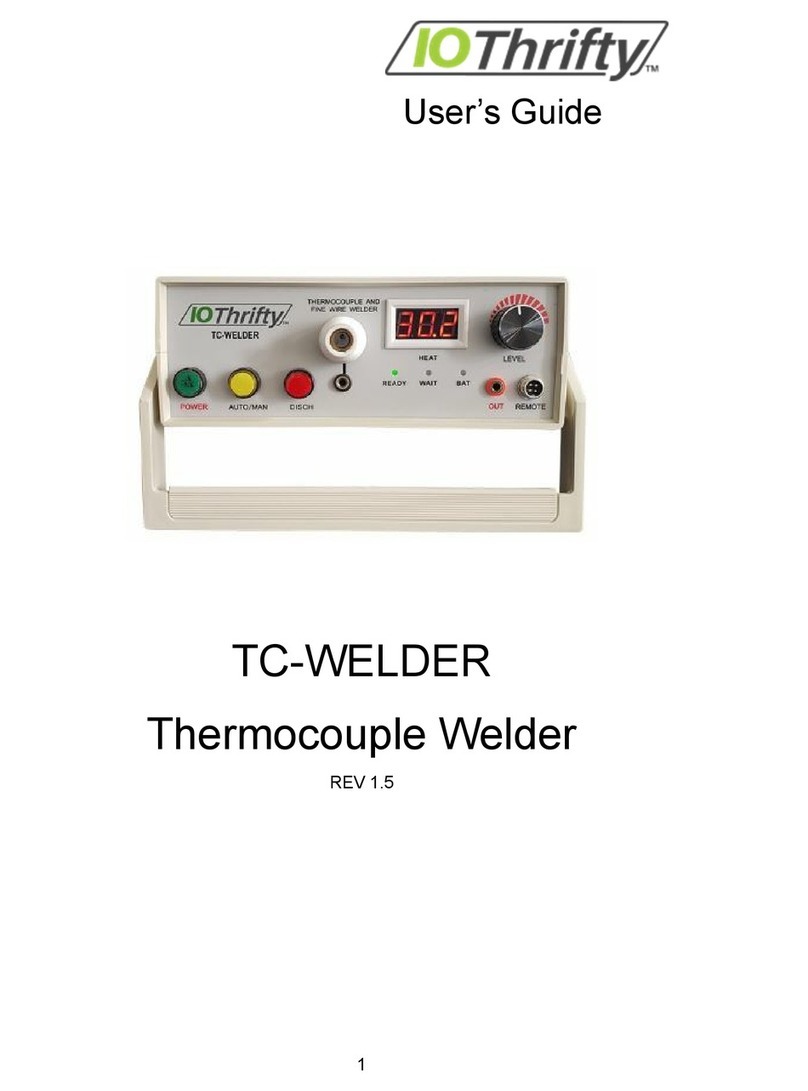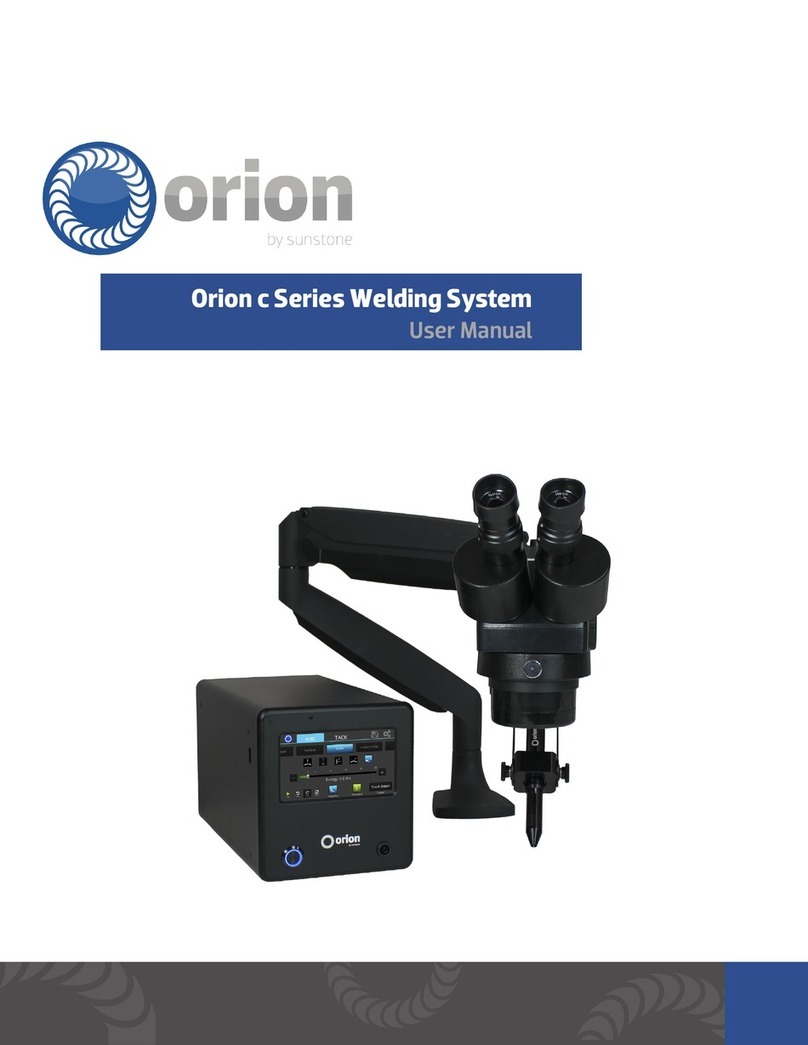Finixa SWD 00 User manual

1/25
SWD 00 –SPOTWELDER 160

2/25
SWD 00 –SPOTWELDER 160
Table of contents
WARNING ..........................................................................................................................................................3
INTRODUCTION ................................................................................................................................................6
MULTIFUNCTIONAL WELDER SPECIFICATIONS.........................................................................................7
Specifications .................................................................................................................................................7
Receiving and Unpacking the Welder ............................................................................................................8
WELDER CONNECTIONS.................................................................................................................................9
How to connect the power cord - Precautions...............................................................................................9
Ground Cable.................................................................................................................................................9
START-UP.......................................................................................................................................................10
LANGUAGE SELECTION.................................................................................................................................10
MODE AND SETTINGS ...................................................................................................................................11
1. Tack welding with cables and one contact tip..........................................................................................11
2. How to weld nails, wiggle wire and washers ...........................................................................................13
3. How to weld molding rivets......................................................................................................................14
4. Energic Slide Hammer With Tip 13.PS.10.29 ..........................................................................................15
5. Shrinking With Copper Tip For Heat Treatment......................................................................................16
6. Shrinking With Carbon Rod .....................................................................................................................17
7. Half Moon Stitch Welding........................................................................................................................18
LIST OF ACCESSORIES .................................................................................................................................19
TROUBLESHOOTING......................................................................................................................................20
EXPLODED VIEW............................................................................................................................................21
WIRING DIAGRAM..........................................................................................................................................24
ANNEXE A: GENERAL SET-UP TABLE....................................................................................................25

3/25
SWD 00 –SPOTWELDER 160
Warning
1. Read, study and understand all warning and
operating instructions furnished with this equipment
prior to use. If any part of this material is unclear,
contact the factory for clarification.
2. Only qualified persons are to install, operate and
maintain this equipment in accordance with applicable
codes, safety practices and manufacturer’s
instructions.
3. Electric shock can be fatal, therefore:
A. Install and ground unit in compliance with
national, regional and local codes.
B. Protect hands and body with dry, insulated
gloves and clothing.
C. Do not operate in damp or wet area.
4. Fumes and gases can be seriously harmful to an
operator’s health, therefore:
A. Operate this equipment in well-ventilated
area. If this is not possible, use air-supplied
breathing apparatus.
B. Welding of containers can result in poisonous
fumes. Ensure that all containers are empty
and properly cleaned prior to welding.
5. Hot metal slag and sparks may cause fire, burns and
explosions, therefore:
A. Do not operate in explosive atmosphere such
as one containing paint, solvents, degreaser
or gasoline fumes.
B. Do not operate near combustible materials.
C. Have appropriate fire extinguisher available
and know how to use it.
D. Allow workpiece to cool before handling.
6. Refer to the operating manual supplied with this
equipment for all safety information.
7. It is owner’s responsibility to keep all warning decals
legible and intact. Replacement decals are available
from the factory.
8. Failure to heed these warning may result in personal
or fatal injury and/or equipment and property damage.
Read and carry out all instructions included in this
manual as well as the following specific procedures.
When one of the symbols shown here is displayed, be
alert to the possibility of personal injury and carefully
read the message that follows.
ELECTRICK SHOCK
Electric shock hazard exists during the
operation of the step(s).
RISK OF FIRE AND BURNS
Fire hazard and possibility of being burned
by hot slag exists during the operation of the
step(s).
Helmet must be worn during the step(s) to
protect against eye damage, flying debris
and bums due to flash hazard.
FUMES AND GASES
Toxic gas hazard exists during operation of
the step(s).
EXPLOSIONS
Possibility of injury or death exists due to
improper handling and maintenance of
compressed gas cylinders or regulators.
NOISE
This welding machine can produce sounds
which can inconvenience the user, the wear
of a protection for the ears is advised.
MAGNETIC FIELDS
This welding machine produces an
electromagnetic fields created by a high
current. Any person wearing vital electronic
equipment (pacemakers) have to consult a
medical specialist before using this machine.
Published standards on safety are available. They are
listed in ADDITIONAL SAFETY INFORMATION at the
end of this SAFETY SUMMARY.
The National Electrical Code, Occupational Safety
and Health Act regulations, local industrial codes
and local inspection requirements also provide a
basis for equipment installation, use, and service.

4/25
SWD 00 –SPOTWELDER 160
SHOCK HAZARDS
WARNING!
ELECTRIC SHOCK CAN KILL!
To reduce the risk of death or serious injury from
shock, read, understand, and follow the following
safety instructions. In addition, make certain that
anyone else who uses this welding equipment, or who
is a bystander in the welding area understands and
follows these safety instructions as well.
IMPORTANT! TO REDUCE THE RISK OF DEATH,
INJURY, OR PROPERTY DAMAGE, DO NOT
ATTEMPT OPERATION of this welding equipment
prior to having read and understood the following
safety summary.
· Do not, in any manner, come into physical contact
with any part of the welding current circuit. The
welding current circuit includes:
a. the work piece or any conductive material in contact
with it,
b. the ground clamp,
c. the threaded stud,
d. metallic parts on the stud gripping clamp.
· Do not weld in a damp area or come in contact with a
moist or wet surface.
· Do not attempt to weld if any part of clothing or body
is wet.
· Do not allow the welding equipment to come in
contact with water or moisture.
· Do not drag welding cables, the welding gun, or
welder power cord through or allow them to come into
contact with water or moisture.
· Do not touch welding machine, attempt to turn welder
on or off if any part of the body or clothing is moist or is
in physical contact with water or moisture.
· Do not attempt to plug the welding machine into the
power source if any part of body or clothing is moist, or
if you are in physical contact with water or moisture.
· Do not connect welder ground clamp to or weld on
electrical conduit.
· Do not alter power cord or power cord plug in any
way.
· Do not attempt to plug the welder into the power
source if the ground prong on power cord plug is bent
over, broken off, or missing.
· Do not allow the welder to be connected to the power
source or attempt to weld if the welder, welding cables,
welding site, or welder power cord are exposed to any
form of atmospheric precipitation, or salt water spray.
· Do not carry coiled welding cables around shoulders,
or any other part of the body, when they are attached
to the weld machine.
· Do not modify any wiring, ground connections,
switches, or fuses in this welding equipment.
· Wear welding gloves to help insulate hands from
welding circuit.
· Keep all liquid containers far enough away from the
welder and work area so that if spilled, the liquid can
not possibly come in contact with any part of the welder
or electrical welding circuit.
· Replace any cracked or damaged parts that are
insulated or act as insulators such as welding cables,
power cord, or electrode holder IMMEDIATELY.
FIRE HAZARDS
WARNING!
FIRE OR EXPLOSION CAN CAUSE DEATH,
INJURY, AND PROPERTY DAMAGE!
To reduce risk of death, injury, or property damage
from fire or explosion, read, understand, and follow the
following safety instructions. In addition, make certain
that anyone else that uses this welding equipment, or is
a bystander in the welding area, understands and
follows these safety instructions as well. REMEMBER!
Arc welding by nature produces sparks, hot spatter,
molten metal drops, hot slag, and hot metal parts that
can start fires, burn skin, and damage eyes.
· Do not wear gloves or other clothing that contain oil,
grease, or other flammable substances.
· Do not wear flammable hair preparations.
· Do not weld in an area until it is checked and cleared
of combustible and/or flammable materials. BE
AWARE that sparks and slag can fly 35 feet and can
pass through small cracks and openings. If work and
combustibles cannot be separated by a minimum of 35
feet, protect against ignition with suitable, snug-fitting,
fire resistant, covers or shields.
· Do not weld on walls until checking for and removing
combustibles touching the other side of the walls.

5/25
SWD 00 –SPOTWELDER 160
· Do not weld, cut, or perform other such work on used
barrels, drums, tanks, or other containers that had
contained a flammable or toxic substance. The
techniques for removing flammable substances and
vapors, to make a used container safe for welding or
cutting, are quite complex and require special
education and training.
· Do not weld or cut in an area where the air may
contain flammable dust (such as grain dust), gas, or
liquid vapors (such as gasoline).
· Do not handle hot metal, such as the work piece or
electrode stubs, with bare hands.
· Have fire extinguishing equipment handy for
immediate use! A portable chemical fire extinguisher,
type ABC, is recommended.
· Wear ear plugs when welding overhead to prevent
spatter or slag from falling into ear.
· Make sure welding area has a good, solid, safe floor,
preferably concrete or masonry, not tiled, carpeted, or
made of any other flammable material.
· Protect flammable walls, ceilings, and floors with heat
resistant covers or shields.
· Check welding area to make sure it is free of sparks,
glowing metal or slag, and flames before leaving the
welding area.
FUME HAZARDS
WARNING!
FUMES, GASES, AND VAPORS CAN CAUSE
DISCOMFORT, ILLNESS, AND DEATH!
To reduce risk of discomfort, illness, or death, read,
understand, and follow the following safety instructions.
In addition, make certain that anyone else that uses
this welding equipment or is a bystander in the welding
area, understands and follows these safety instructions
as well.
· Do not weld in an area until it is checked for adequate
ventilation as described in ANSI standard #Z49.1. If
ventilation is not adequate to exchange all fumes and
gasses generated during the welding process with
fresh air, do not weld unless you (the welder) and all
bystanders are wearing air-supplied respirators.
· Do not heat metals coated with, or that contain,
materials that produce toxic fumes (such as galvanized
steel), unless the coating is removed. Make certain the
area is well ventilated, and the operator and all
bystanders are wearing air-supplied respirators.
· Do not weld, cut, or heat lead, zinc, cadmium,
mercury, beryllium, or similar metals without seeking
professional advice and inspection of the ventilation of
the welding area. These metals produce EXTREMELY
TOXIC fumes which can cause discomfort, illness, and
death.
· Do not weld or cut in areas that are near chlorinated
solvents. Vapors from chlorinated hydrocarbons, such
as trichloroethylene and perchloroethylene, can be
decomposed by the heat of an electric arc or its
ultraviolet radiation. These actions can cause
PHOSGENE, a HIGHLY TOXIC gas to form, along with
other lung and eye-irritating gasses. Do not weld or cut
where these solvent vapors can be drawn into the work
area or where the ultraviolet radiation can penetrate to
areas containing even very small amounts of these
vapors.
· Do not weld in a confined area unless it is being
ventilated or the operator (and anyone else in the area)
is wearing an air-supplied respirator.
· Do not weld in a confined area unless it is being
ventilated or the operator (and anyone else in the area)
is wearing an air-supplied respirator.
· Stop welding if momentary eye, nose, or throat
irritation develops as this indicates inadequate
ventilation. Stop work and take necessary steps to
improve ventilation in the welding area. Do not resume
welding if physical discomfort persists.
PROTECTION AGAINST MAGNETIC FIELD
WARNING!
The magnetic field can be a cause of trouble to
operators who have HEART MONITORS, PACE-
MAKERS, AUDITIVE APPARATUS, AND/OR
COCHLEAIRE IMPLANTS (HEARING AIDS). Do not
carry any credit card or magnetic card when using any
welding machine.

6/25
SWD 00 –SPOTWELDER 160
Introduction
You are the lucky owner of the new multiple function
dent pulling system, COMPUSPOT CPS160 developed
especially for body men. You have made the right
choice and we congratulate you.
Your COMPUSPOT CPS160 dent pulling system was
designed to perform most panel work calling for the
application of studs, washers, and rivets. It can easily
carry out even the most delicate procedures which until
today represented a major undertaking.
The Body Man’s Perfect Dent Pulling Tool
Among the different dent pulling techniques applied to
maintenance work on car bodies, low amperage spot
welding application of studs, pins, wiggle wire, or
washers is the most economical, the fastest, and the
most suitable for the sheet metal used in today's
automobiles. Thanks to this method, the damage of
assembled parts is reduced to a minimum - it is
negligible and even invisible in many cases. The
structure of high-resistant sheet metal is not affected.
Further, this type of application does not requires
special training.
This machine can produce excellent results for many
years to come; read this manual carefully so as to draw
the full benefits from this equipment and keep it in
perfect running order.
- Mode, power and time settings are easy to make,
making this multifunctional welder an efficient,
user-friendly tool.
- By observing the precautions set forth for the
operation and maintenance of the welder and its
accessories, the operator will achieve excellent
results in each mode.
- This dent pulling system can be used by
programming the time (stops automatically when
time has expired) or by manual control.
- The welding cables are flexible, easy to handle
and a convenient length (2 m) for all
operations.
- The accessories provided with the equipment
enable the operator to do most of automotive
panel repair work.
TIME CONTROL /
CONTRÔLE TEMPS
POWER CONTROL /
CONTRÔLE PUISSANCE
DISPLAY WINDOW /
FENÊTRE D’AFFICHAGE
I/O PILOT /
TEMOIN I/O
OVERHEATING
INDICATOR /
INDICATEUR
DE SURCHAUFFE
WELD INDICATOR /
TÉMOIN DE SOUDURE
CARBON ROD MODE /
MODE CRAYON CARBONE
DEMI-LUNE MODE /
HALF-MOON MODE
GENERAL MODE
(NAIL,WASHER,RIVET,
WIGGLE WIRE,SHRINKING)/
MODE GENERAL
(CLOU,RONDELLE,RIVET,FIL
ONDULE,RETREINT)

7/25
SWD 00 –SPOTWELDER 160
Multifunctional Welder Specifications
Specifications
General
Voltage
208/240 V Single Phase
380/415 V Single Phase
Frequency
50/60 Hz
50/60 Hz
Fuses
30 A, delay
20 A, delay
Welding Current
2100/3500 A
2100/3500 A
Open Circuit Voltage
7 V
7 V
Duty Cycle
7 %
7 %
Power Rating
2.0/2.9 kVA
2.0/2.9 kVA
Mechanical Specifications
Power Cord Length
8 m
Welding Cable Length
2 m
Electricity: Basic Rules to be
Observed
Voltage
For the COMPUSPOT CPS160 run properly, it is
essential that the power supply correspond to the
voltage listed on the identification plate attached to the
rear of the machine.
Amperage
The welding unit must be connected to an outlet rated
at 30A (or 20A for the 380V model) with a delay fuse or
time limiting breaker.
Remedy for insufficient power supply
The outlet to which the COMPUSPOT CPS160 dent
pulling system will be connected must be reinforced.
Replace the circuit breaker or the fuses. In some
cases, it may even be necessary to change the
conductors.
Final precaution
Avoid connecting several units to the same line as the
dent pulling system when the line is calibrated at 30A
(or 20A for the 380V model).

8/25
SWD 00 –SPOTWELDER 160
Receiving and Unpacking the
Welder
First remove the slide hammer, manual, and accessory
package from the box. Remove any packing material
surrounding the machine. Then lift the machine
straight up and out of the box.

9/25
SWD 00 –SPOTWELDER 160
Welder Connections
How to connect the power cord -
Precautions
The CompuSpot160 dent pulling comes with a 8-m
power cord permanently connected to the unit. This
cord contains 3 conductor wires of the same diameter:
Black and white (Run on 240V/400V or 380/415V –
50/60Hz, Single Phase)
Green (GROUND; must always be connected for
important safety reasons).
The operator must supply a properly rated plug to
match the outlets in the shop.
Do not make any trial runs or tests with the
machine before checking the circuit breaker, the
outlet, and the wiring configuration on the plug.
Connect the ground wire (green) to the ground post of
the plug being installed. Most single phase 240/400
volt plugs have 3 terminals and 3 posts. The 2 wires of
the power cord fit are then connected to the 2
remaining terminals.
TIP
Avoid adding an extension to the power cord. If it
is too long, it may cause a drop in power. If an
extension or drop cord must be used, its size and
rating must be the same or greater than that of the
power cord mounted on the machine.
Ground Cable
Location
Choosing and preparing the place where to apply the
ground plate is very important.
Fix the ground plate directly to the part of the car body
to be repaired, near the work area (less than 3 feet/1
m).
Example : When dent pulling on a door panel,
attach the ground plate to the panel itself. For further
work on the same car, move the ground plate.
Cleaning
Carefully prepare the spot where the ground plate will
be installed to ensure excellent electrical contact: strip
all paint and filler from the sheet metal. Clamp the
ground plate firmly against the body part with vise grip
pliers to obtain perfect electrical contact. Magnetic
clamps may be used provided they are powerful
enough that use of a slide hammer will not dislodge the
ground plate.
Maintenance
After having used the machine for a certain period of
time, clean the ground plate with an abrasive pad or
light file, if necessary.

10/25
SWD 00 –SPOTWELDER 160
Start-Up
1. Connect the power cord to an electric outlet rated at
240 V, single phase - 30 Amps (400 V, single phase –
20 Amps for 380-400V model).
2. Turn the switch located in the lower right-hand
corner of the front. (power knob)
1 = power on; pilot light begins flashing
and then stays on.
0 = off
3. Select the desired mode.
4. Select the desired power.
5. Set the welding time to the minimum required for the
dent pulling application.
NOTE: Most of the modes can be implemented
automatically or manually. The automatic mode has
only to do with the welding time.
Automatic position
The length of time which is preset can be initiated by
pressing the switch on the welding gun handle.
Manual position
The welding time is completely controlled manually by
the operator pressing and releasing the trigger switch
on the contact handle.
It must be modified (increased or decreased)
depending upon the variations in shop voltage, the
local electrical network, and other electrical equipment
installed in the shop.
It will also vary depending on the thickness of the sheet
metal upon which work is being done.
Language selection
The machine is programmed for three different
languages: French, English and German. Press on
the two down arrows at the same time to select the
desired language.
OVERHEATING WARNING
There is an overheating if the yellow indicator lights
ON and the following message appears:
The machine automatically stop when there is an
overheating in the power components. Please wait
at least 30 minutes before using the machine or until
the machine has cooled down. If the problem
persists, call AMH Canada or your local dealer.
Down arrow 1
Down arrow 2

11/25
SWD 00 –SPOTWELDER 160
Mode and Settings
1. Tack welding with cables and
one contact tip
IMPORTANT: While the CPS160 is an extremely
powerful dent pulling system, it is NOT designed for
panel installation. The tack welding process described
below is used only to attach very thin patch material or
to hold a panel in place so that MIG welding or spot
welding with a more powerful resistance spot welding
machine can be performed.
Equipment
- standard contact tack weld tip 04.PS.15.18
REMINDER
- Mount one well-sharpened tip on the tip holder
located on the control handle of the welding gun.
- Attach the ground plate.
- Prepare and strip the sheet metal for tack welding.
NOTE: For patch material use stainless sheet metal
0.4mm (26 ga) Strip both sides of the upper piece
of the patch sheet metal and the outside surface of
the lower piece of sheet metal on which the patch
will be applied.
How to fasten the ground plate
Two ways to fasten the ground plate.
1. Strip the part of the sheet metal where the ground
plate is to be attached.
2. or weld a washer on the metal surface and fasten
the ground plate on with the block grip.
Welder settings
Choice of setting depends on several factors :
- Power supply to the machine (voltage)
- Quality and thickness of sheet metal to be assembled.
COMMENT: For stronger welds it is always
preferable to increase the power settings and
reduce the welding time to a minimum.
- Press on GENERAL MODE symbol until the
MONOPOINT mode is selected.
- Set power.
- Set time.

12/25
SWD 00 –SPOTWELDER 160
Example for contact tip*:
*The values displayed in this example are suggested
but can be adjustable.
NOTE: The first tack welds made using the above-
mentioned settings will serve as a guide in selecting
the appropriate setting for subsequent welds.
Sharpening the tips
For optimum efficiency and to avoid overheating, the
tips must be regularly cleaned and sharpened.
NOTE
In tack welding mode :
- do not press down hard on the tips;
- for greater penetration, increase the power
setting;
- make sure the sheet metal is clamped tightly
together before welding;
- prepare and clean properly the surface of the
sheet metal to be assembled.

13/25
SWD 00 –SPOTWELDER 160
2. How to weld nails, wiggle wire
and washers
Mount the tip for desired mode on the tip holder of the
handle with switch.
Equipment
- Nail tips : 04.PS.15.25
- Washer tips : 04.PS.15.05
- Wiggle wire tip: 04.PS.15.30
- Strip the part of the sheet metal to be welded
How to fasten the ground plate
Two ways to fasten the ground plate.
1. Strip the part of the sheet metal where the ground
plate is to be attached.
2. or weld a washer on the metal surface and fasten
the ground plate on with the block grip.
Settings for nails, wiggle wire and washers
- Press on GENERAL MODE symbol until the
appropriated mode is selected:
•NAIL/STAR for nails;
•SINGLE SPOT for wiggle wire;
•WASHER/SHRINK for washers.
- Set power.
- Set time.
Example for nails*:
Example for wiggle wire*:
Example for washers*:
*The values displayed in this example are suggested
but can be adjustable.
NOTE: After dent extraction with a puller or another
means of pulling, remove the washers by breaking
the welds with simple clockwise rotation of the
pulling hook.
Nail Tip
Washer Tip
Wiggle Wire Tip

14/25
SWD 00 –SPOTWELDER 160
3. How to weld molding rivets
Equipment
- Molding rivet tip : 04.PS.15.20
When welding, the molding rivets and support sheet
metal should not exceed a bluish colour. Never heat
until red.
COMMENT: To facilitate rivet installation, the rivet-
holder tip is magnetized.
NOTE: Molding rivets are used either to attach trim
or door guards or to remove small dents from
panels with a rivet puller.
- Strip the area of the sheet metal to be worked on.
How to attach the ground plate
Two ways to fasten the ground plate.
1. Strip the part of the sheet metal where the ground
plate is to be attached.
2. or weld a washer on the metal surface and fasten
the ground plate on with the block grip.
Setting for molding rivets
- Press GENERAL MODE symbol until you get
the NAIL/STAR mode.
- Set power.
- Set time.
Example for molding rivets*:
*The values displayed in this example are suggested
but can be adjustable.

15/25
SWD 00 –SPOTWELDER 160
4. Energic Slide Hammer With
Tip 13.PS.10.29
This means of dent pulling is very quick; the time of
implementation is reduced compared to other means of
pulling (of washers, nails, etc.). The use of this puller is
limited in certain cases, however.
Equipment
- Energic slide hammer 13.PS.10.29
Use :
- Remove the handle of the slide hammer.
- Slide the collar of the slide hammer over the end of
the electrode holder in the contact handle.
- As in the previous applications, attach the ground
plate to the stripped sheet metal.
- Align the wing bold with the detent in the electrods
holder and tighten the slide hammer to the switch
handle.
- After pulling, rotate the tip clockwise once to break the
weld.
Note: Use a fill to remove a small amount of the
copper coating on the leading edge of the star
washer before working.
How To Attach The Ground Plate
Two ways to fasten the ground plate.
1. Strip the part of the sheet metal where the ground
plate is to be attached.
2. or weld a washer on the metal surface and fasten
the ground plate on with the block grip.
Settings for energic slide hammer
- Press GENERAL MODE symbol until you get
the NAIL/STAR mode.
- Set power.
- Set time.
Example forEnergic slide hammer*:
*The values displayed in this example are suggested
but can be adjustable.
NOTE: The recommended setting is only
approximate. With CPS160 the operator has the
advantage of being able to perfect setting to
achieve ideal welding, in particular by adjusting the
power. By increasing the time, the heating of the
sheet metal is also increased. Too long a welding
time can result in overheating of cables and tips.

16/25
SWD 00 –SPOTWELDER 160
5. Shrinking With Copper Tip For
Heat Treatment
Equipment
- Copper shrinking tip 04.PS.15.10
How To Attach The Ground Plate
Attach the ground plate to a stripped surface less than
3 feet (1 m) from the stripped area where the shrinking
is to be performed.
Two ways to fasten the ground plate.
1. Strip the part of the sheet metal where the ground
plate is to be attached.
2. or weld a washer on the metal surface and fasten
the ground plate on with the block grip.
Setting for shrinking tip
- Press GENERAL MODE symbol until you get
the WASHER/SHRINK mode.
- Set power.
- Set time.
Example for shrinking tip*:
*The values displayed in this example are suggested
but can be adjustable.
This type of shrinking is used to remove small bumps in
the sheet metal and to heat-treat and cool the sheet
metal in order to firm up a panel.
Apply the tip to an even surface and press down on the
tip.
NOTE: Should spatter and sparks be produced
upon contact, clean the tip and perform the
shrinking operation firmly pressing down on the
tip.

17/25
SWD 00 –SPOTWELDER 160
6. Shrinking With Carbon Rod
Equipment (Optional)
- Carbon rod: 02.205.01.60
- Carbon rod adaptor: 04.PS.20.36
Mount the carbon rod and adaptor on the switch
handle.
Settings for shrinking (with carbon rod)
- Press on the CARBON ROD symbol.
- Adjust the power. As the machine will be in the
manual mode, current will be flowing as long as the
trigger switch is held down.
Example for shrinking with carbon rod:
*The values displayed in this example are suggested
but can be adjustable.
NOTE: The power setting should be selected in
such a manner as to ensure that the tip does not
create sparks or exceed a light reddish colour.
How To Attach The Ground Plate
Clamp the ground plate in an area near the surface to
be shrunk (less than 3 ft/1 m) on the same panel or
piece of metal.
Two ways to fasten the ground plate.
1. Strip the part of the sheet metal where the ground
plate is to be attached.
2. or weld a washer on the metal surface and fasten
the ground plate on with the block grip.
IMPORTANT:Thoroughly clean the part of the sheet
metal to be worked and which comes into contact with
the ground plate.
Application
1. Press the switch button on the control handle. The
electricity passes as soon as the tip comes into contact
with the sheet metal. It is continuous.
2. Shrinking or elimination of a high spot or over
pulled area.
Apply the tip lightly to the sheet metal and move it as if
writing with a pen.
3. Shrinking a panel which has lost firmness
or strength due to dent pulling
Move the tip slowly drawing concentric circles or
continuous spirals on the sheet metal. Move from the
outside of the work area toward the center. Cool with a
wet rag, sponge, or spray bottle.

18/25
SWD 00 –SPOTWELDER 160
7. Half Moon Stitch Welding
Mount the half moon shaped tip for the desired mode
on the tip holder of the handle switch.
Equipment
- Half moon electrode: 04.PS.15.15
Settings for half moon mode
- Press on the HALF MOON symbol.
- Set power.
- Set time.
Example or half moon mode*:
*The values displayed in this example are suggested
but can be adjustable.
NOTE: The welding time is pre-set . Only the time
"OFF" can be set by the using the timer knob.
- Strip the part of the sheet metal to be weld.
- Place a 0.4mm thick stainless sheet metal over the
area to be patched. Place the half moon electrode on
the edge of the stainless, and by pulling the trigger
switch, weld it with a rocking movement.
NOTE: The machine will continue stitch welding as
long as the trigger switch is held down.
How To Attach The Ground Plate
Attach the ground plate to a stripped surface less than
3 feet (1 m) from the stripped area where the shrinking
is to be performed.
Two ways to fasten the ground plate.
1. Strip the part of the sheet metal where the ground
plate is to be attached.
2. or weld a washer on the metal surface and fasten
the ground plate on with the block grip.

19/25
SWD 00 –SPOTWELDER 160
List of Accessories
No. AMH
Description
16.178.00.72
Washers (set of 100)
16.178.00.71
Molding rivets (set of 100) for
extraction or attachment of door
guards
16.178.00.67
Nails (set of 100)
04.PS.15.18
Standard tack weld tip
04.PS.15.05
Washer tip
04.PS.15.25
Nail tip
04.PS.15.10
Copper shrinking tip
04.PS.15.20
Molding rivet tip
13.PS.10.31
Washer puller with hock
13.PS.10.27
Nail mandrel
04.PS.20.36
Electrode holder adaptor
13.PS.10.29
Electric washer puller with tip
adapter
13.PS.10.45
Block grip
13.155.00.36
Flat tips for puller 13.PS.10.29
(set of 10)
Optional:
13.155.10.76
Wiggle wire (1lb/pk)
13.155.10.50
8 Finger bear claw for jack
13.155.30.07
Hand lifter
13.155.10.45
5 Finger bear claw for hammer
14.CS.00.20
Cart

20/25
SWD 00 –SPOTWELDER 160
Troubleshooting
Sheet metal burn through
Power and/or welding time settings too high or poor
contact between tip and sheet metal. Also, in the case
of tack or stitch welding a patch a gap may exist
between the patch and the panel.
Poor contact
•
Tip(s) need to be cleaned; metal particles of the
welding surface stick to tip. Poor contact of
electric current owing to dirty tip.
•
To improve contact of tip(s) with the welding
surface, turn the tips around at each weld when
it comes into contact with the sheet metal.
•
With a fine emery cloth or light abrasive pad,
clean periodically the tip holder surface which is
in contact with the tip.
Tip removal
Tips may be removed from the tip holder by tapping
lightly on the tip holder with a fiber hammer.
Poor or weak welds
•
The surfaces to be assembled have not been
cleaned properly.
•
Power or welding time settings are not
adequate.
•
Too much pressure on the tip and sheet metal
to be assembled.
Welder Failure
Problem
Diagnosis
Remedy
Poor electrical operation.
Check cables to see if they are
properly connected and held in place
on welder.
Make sure the control handle switch
is working properly.
Does not work and there is no sign
that power is on when switch is in
the ON position.
Failure often stems from power cord
which has been bent many times at
the ends, chiefly near the connecting
plug. The wires are broken or badly
worn so that passage of electrical
current is impaired. In this case the
plug is very hot if the internal
connection is not good.
Remove the plug, attach correctly
the wires inside the plug or change
the plug if defective.
Check the circuit breaker, fuses,
etc., and power line.
No power setting.
Not time setting.
Pilot lights come on and current
passes through the tips.
Humming sound is produced when
power and time settings are set at
maximum without welding or
pressing the switch button of the
handle.
Defect in control circuit electrical
panel.
The welder must be repaired by an
approved shop.
If problem(s) persist, contact your dealer
This manual suits for next models
1
Table of contents


